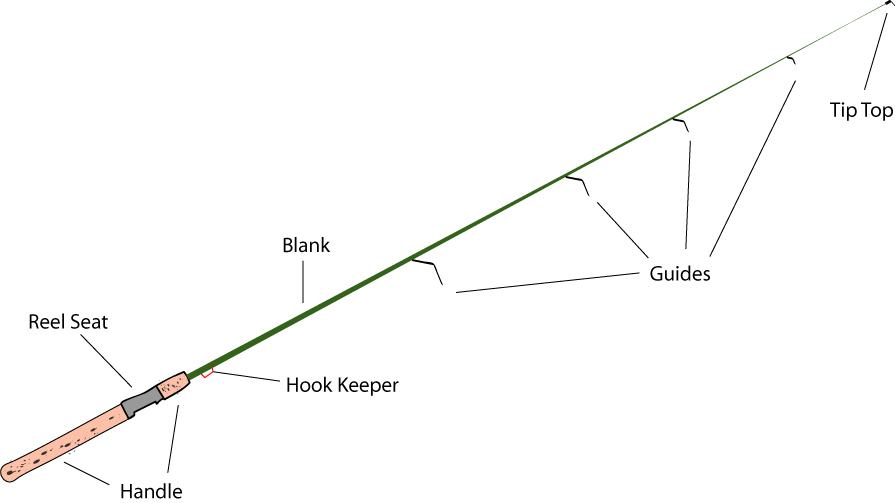Fishing Rod Basics
Justin Clark 09.06.11

Over the years I have explained this to many fishermen. I also see question on the online forums all the time about what is a good sensitive rod.Or what kind of action rod is best for this or that. Many times anglers get action and power mixed up, or they think they’re the same thing.This isn’t their fault cause for years rod companies did a poor job of explaining fishing rod basics.
Rod Anatomy
Blank: The blank, the foundation of a Fishing rod. It is what all the following items go on to..
Handle: The handles are made of Cork or EVA foam that’s placed on the blank. This is the area that we fishermen grip when we hold a fishing rod.On some rods this is split into two section, the rear grip, and fore grip.
Reel Seat: The reel seat is the place where the fishing reels placed on the rod. There is many styles out of reel seats but they all work basically the same.
Hook Keeper: The hook keeper is not found on all rods, but is a handy thing that can be added to any rod that doesn’t have one. It’s located just above the handle or fore grip. This is where you should always hook your lure or hook to when you’re not fishing with it. Never put it on the eye this can cause nicks in the guide which will fray your line.
Guides: Guides are placed along the blank, this is what your line goes through on the rod. The amount of guides will depend on the quality and length of the rod.They are attached to the rod with something called winding, this is basically a thread used to attach the guides to the rods.
Tip Top: The tip top is the very last guide on a rod. This goes on the end of the blank towards your fishing lure or hook.
Rod Action
Rod action refers to the responsiveness of the rod.Another way to think of it is the speed the rod returns back being straight or neutral .The action lets you know how fast the rod will get into its power or back bone. This is very important when choosing your rod. You want to match up the rods action to the fishing technique you are doing. For example if you are Flipping and Pitching you want a rod with a fast to Ex-fast action.But if you are casting crankbaits you want a rod with a moderate fast to moderate action, this helps improve your hooking percentage when fishing these baits.
Power
Power refers to the amount of force the rod can deliver. This gives you an idea of what kind of fish or technique it’s designed for. There is two ways this is labeled on the rod. The most common is a ranking system using words like Ultra light, Med, and Heavy. The other system uses a number to denote its power level. The chart to the left explains this further and compares the two. The power ratings can vary from rod maker to rod maker sometimes. But generally all Medium power rods feel about the same.
Lure and Line Weight
 On every rod you will see a lure and line rating. What this tells you is what the rod was designed to be used with. You will get the best performance within those ratings. Now this is super important never ever go heavier with your lure weight then what the rating states on the rod if you are casting. This can cause the rod to break during the cast.Also take care when using stronger fishing line then what the rod is rated for. If you use stronger line and you get hung up or the reel locks up the rod could break before the line does.
On every rod you will see a lure and line rating. What this tells you is what the rod was designed to be used with. You will get the best performance within those ratings. Now this is super important never ever go heavier with your lure weight then what the rating states on the rod if you are casting. This can cause the rod to break during the cast.Also take care when using stronger fishing line then what the rod is rated for. If you use stronger line and you get hung up or the reel locks up the rod could break before the line does.
Sensitivity
Rod sensitivity is the rods ability to transmit vibration from the line to the rod and then into the angler’s hand and arm.Just because a rod tip is whippy does not mean it is sensitive, it just means it bends easily. The biggest factor in rod sensitivity is the material(s) the rod is construed from. The most common materials a blank is made from are Fiberglass and Graphite ,or a mixture of the two.Graphite or carbon is the best at transmitting vibration, the only draw back tho is durability, but this is quickly changing has things advance. Fiberglass is the cheaper of the two and is not up to par with transmitting vibration. Glass rods tends to be a bit more durable and tends to have a softer feel to them. Now a days though rod makers have began to mix the two to create specialty rods mostly for crankbait fishing.
This is just a very basic look at rods. There is a few more things to them but this is a good starting point. If you have questions on rods feel free to e-mail me: outinmich@gmail.com.
Copyright © 2011 Out in Michigan LLC




